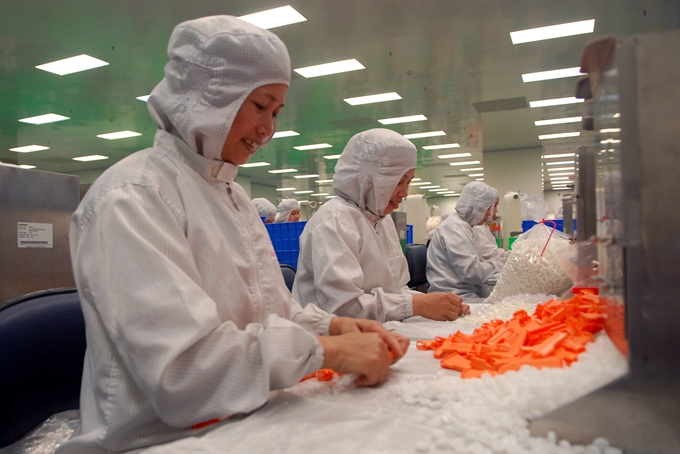 Economy
Economy

The Nikkei manufacturing PMI (Purchasing Managers Index) of Việt Nam has bounced back strongly, jumping to a nine-month high of 52.3 in April from a previous 50.7, in contrast to weaker PMIs for the rest of the region, according to the monthly "Vietnam at a glance" report from HSBC.
 |
| Photo taken of workers at the B.Braun Việt Nam Company Limited, a Germany-funded medical equipment producer. Disbursed FDI was US$3.5 billion as of March, marking a 15 per cent year-on-year increase. VNA/VNS Photo Danh Lam |
HCM CITY – The Nikkei manufacturing PMI (Purchasing Managers Index) of Việt Nam has bounced back strongly, jumping to a nine-month high of 52.3 in April from a previous 50.7, in contrast to weaker PMIs for the rest of the region, according to the monthly "Việt Nam at a glance" report from HSBC.
Improvement was broad-based, output, new orders and new export orders all rising strongly.
The pick-up in manufacturing activity is expected to remain in the coming months, with new orders minus inventories (a leading indicator of output) staying firm.
More encouragingly, employment continues to pick up, suggesting that producers remain confident in the business outlook.
The country remains a magnet for foreign investment.
The resilience of Việt Nam’s manufacturing reflects the country’s success in expanding global market share amid weak global trade.
This is largely thanks to foreign direct investment (FDI), which has continued to surge in 2016.
With new factories commencing operations this year, FDI is expected to drive a recovery in export growth to 10.1 per cent year-on-year in 2016.
Solid manufacturing sector growth should help support growth amid deteriorating activity in the primary sector.
Disinflationary pressures are fading, but the State Bank of Việt Nam (SBV) should be in no hurry to hike rates.
Meanwhile, headline inflation continued to pick up in April, rising 1.9 per cent year-on-year.
The latest PMI report also showed a noticeable jump in input prices, suggesting that the disinflationary pressures from lower commodity prices are starting to fade.
But the increase in output prices has been more modest, and core inflation pressure is anticipated to remain manageable.
The State Bank of Việt Nam will be in no hurry to hike rates especially since we see growth cooling this year to 6.3 per cent year-on-year, from 6.6 per cent in 2015.
Việt Nam’s manufacturing sector hit a bit of a soft patch in Q1 2016, with GDP-based output falling 0.1 per cent quarter-on-quarter (seasonally adjusted), marking the first contraction since March 2012.
But the strong April PMI results point to a rebound in Q2 2016. The report believes output will continue to rise in the months ahead.
The leading indicator–new orders minus inventories–eased slightly in April but remains at very high levels.
Manufacturers have also been ramping up headcount (the employment index jumped to an 11-month high), reflecting confidence in the business outlook.
The resilience of Việt Nam’s manufacturing sector does not necessarily reflect robust global demand but rather continued new investment in the country.
In 2015, disbursed FDI climbed to a record high $14.5billion, thanks to strong inflows from South Korea and Malaysia.
The former retained its spot as Việt Nam’s top investor 2016, with year-to-date registered FDI approaching $2.5 billion (or over 90 per cent of last year’s total) as of April.
Total disbursed FDI was up $3.5 billion as of March, marking a 15 per cent year-to-date, year-on-year increase.
With new factories commencing operations, output has continued to rise despite sluggish external demand, driving the continued performance of Việt Nam’s manufacturing sector vis-à-vis its neighbours.
In April, export growth improved to 6 per cent year-to-date, year-on-year, up from 4.1 per cent in March.
This is weaker than growth rates recorded during the same period last year, but sequential momentum has been improving.
Shipments of smartphones (phones and spare parts) continue to be the driver, rising 25 per cent year-to-date, year-on-year in April (up from 13.6 per cent during the same period last year).
The strong growth in the first quarter of this year was partly buoyed by new product launches by Samsung (Việt Nam’s biggest foreign investor).
Whereas manufacturing momentum has fizzled in the rest of the region, the recovery in Việt Nam looks to be more sustainable as it is driven by new FDI coming online.
FDI is expected to drive a recovery in export growth to 10.1 per cent year-on-year in 2016, up from 7.9 per cent last year.
The resilience of the manufacturing sector should help support growth against a backdrop of deteriorating activity in the primary sector due to El Nino effects.
Inflation up but price pressure stable
Meanwhile, April brought further evidence that disinflationary pressures from lower commodity prices are bottoming out.
Notably, the input price subindex in the April PMI report jumped 3.9 points to the highest level since August 2014.
The index will not continue to accelerate further on a sustainable basis. Oil prices, while showing signs of bottoming out, remain well behaved.
Headline inflation rose to 1.9 per cent year-on-year in April, marking the sixth consecutive month of increase, but the sequential rise was mainly driven by food inflation, influenced by El Nino-related supply-side disruptions. This has been a theme across the region.
Meanwhile, core inflation rose 0.2 point to 1.8 per cent, but this was more of a technical rebound after a moderation in March.
Over the past year, core inflation remained steady at around 2 per cent, and the HSBC report expects this to remain the case through 2016.
Therefore, the SBV will keep the OMO rate unchanged through the first half of 2017. - VNS




